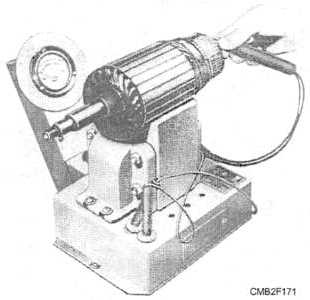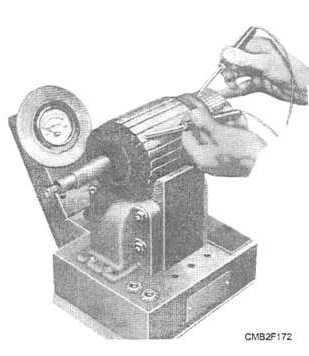following the manufacturer's instructions in using the ohmmeter, field coil tests can be made more quickly and accurately than by using a test lamp circuit.
ARMATURE TEST. - There are two practical tests for locating shorts, opens, and grounds in armatures - the growler test and the bar-to-bar test.
To test for short circuits, place the armature on the V-block of the growler and turn on the current. With a thin metal strip (hacksaw blade is good) held over the core, as shown in figure 2-17, rotate the armature slowly through a complete revolution. If a short is present, the steel strip will become magnetized and vibrate. To find out whether the armature coils of the commutator are short-circuited, clean between the commutator segments and repeat the test. Should the thin metal strip still vibrate, the armature is short- circuited internally and must be replaced.
Not all armatures can be tested for short circuits by the method just described. These armatures can be identified by excessive vibration of the saw blade all around the armature during the test. With these armatures, test for short circuits by using the milliampere contacts on an ac millimeter, as shown in figure 2-18. In doing so, keep the armature stationary in the V-block and move the contacts around the commutator until the highest reading is obtained. Then turn the armature to bring each pair of segments under

Figure 2-17. - Using an armature growler.
the contacts and read the milliammeter at the same time. The readings should be nearly the same for each pair of adjacent bars. If a coil is short-circuited, the milliammeter reading will drop to almost zero.
Test the armature for grounds by using the test light circuit, which is a part of most modern factory- built growlers (fig. 2-19). Place the armature on the V-block and touch one of the test probes to the

Figure 2-18. - Testing an armature for a short circuit with a milliammeter.

Figure 2-19. - Testing an armature for grounds.
Continue Reading